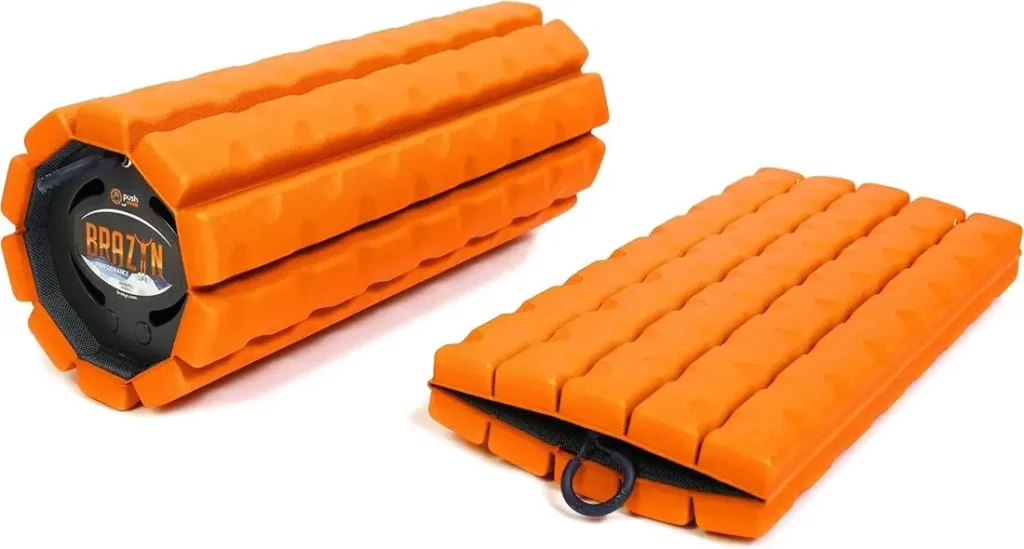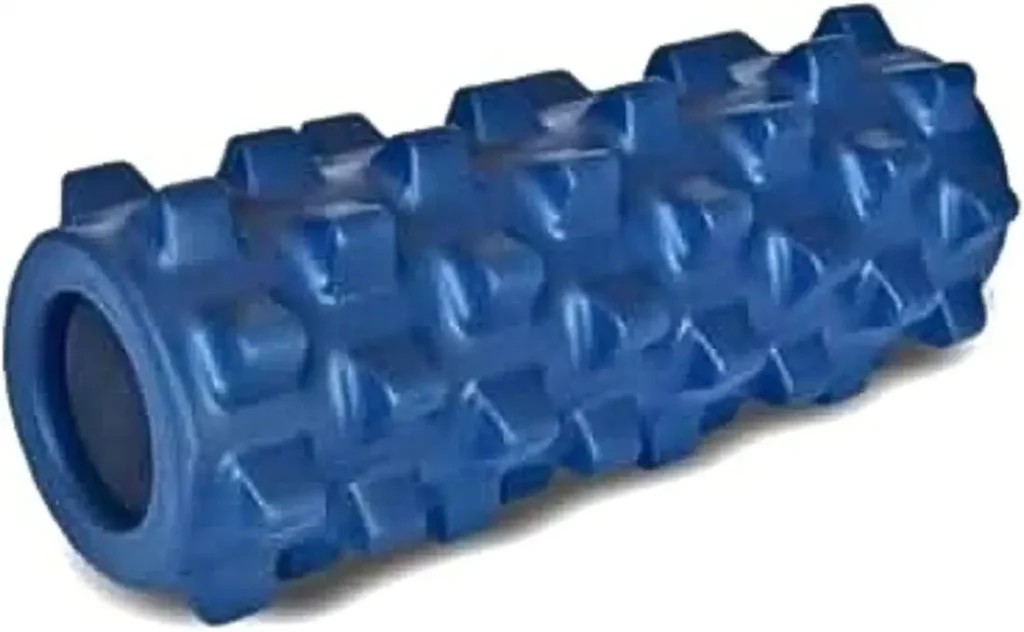A foam roller is one of the most powerful investments you can make in your home fitness routine.
But with hundreds of options on the market, how do you choose the right one?

It’s easy to feel overwhelmed by the choices.
We’ve tested, reviewed, and compared dozens to bring you the definitive list of the 5 best foam rollers available today.
Whether you’re a total beginner or a seasoned athlete, this guide will help you find the perfect tool for your recovery needs.
Before you dive in, make sure you understand the key features by reading our guide on How to Choose the Perfect Foam Roller.
How We Tested – Our Review Criteria
We didn’t just pick random rollers.
To earn a spot on this list, each model was rigorously evaluated based on the criteria that matter most to you:
- Density & Firmness: How well does it provide effective pressure without causing unnecessary pain?
- Durability: Is it built to last through hundreds of sessions without deforming or breaking down?
- Surface Texture: Does the surface provide consistent pressure or targeted relief?
- Size & Portability: Is it versatile for home use or convenient for travel?
- Overall Value: Does the price align with its quality and performance?
The 5 Best Foam Rollers
1. TriggerPoint GRID – Best Overall Foam Roller

The TriggerPoint GRID is the gold standard for a reason.
Its patented multi-density grid pattern is designed to feel like a massage therapist’s hands, with different zones for varying intensity.
It’s constructed with a rigid, hollow core, making it incredibly durable and resistant to losing its shape over time.
| Density | Size | Material | Best For |
| Firm | 13 inches | EVA Foam | All-around use, durability |
Pros:
- Extremely durable hollow-core construction
- Multi-density surface provides targeted relief
- Compact size is great for most uses
Cons:
- Can be too intense for absolute beginners
- Higher price point than basic models
2. Amazon Basics High-Density Roller – Best Budget Pick

If you’re looking for a no-frills, effective tool that gets the job done, this is it.
The Amazon Basics roller is made from high-density expanded polypropylene (EPP), providing firm, consistent pressure.
It’s simple, tough, and comes in various lengths, but the 36-inch model is the most versatile for beginners who need stability for back exercises.
| Density | Size | Material | Best For |
| Firm | 18, 24, 36 inches | EPP Foam | Beginners, budget-conscious users |
Pros:
- Incredible value for the price
- Durable material resists moisture and holds its shape
- Available in multiple sizes
Cons:
- The firm density can be intense for some users
- Basic smooth surface lacks targeted texture
3. OPTP PRO-ROLLER Soft – Best for True Beginners

For those who are highly sensitive or just starting their recovery journey, a rock-hard roller can be intimidating.
The OPTP PRO-ROLLER offers a softer, more gentle compression that allows your muscles to ease into myofascial release without the intense discomfort.
It’s the perfect starting point to build your tolerance.
| Density | Size | Material | Best For |
| Soft | 36 inches | Closed-Cell Foam | Beginners, sensitive muscles |
Pros:
- Gentle compression is ideal for sensitive users
- Durable, professional-quality construction
- Great for improving balance and stability
Cons:
- May be too soft for experienced users or those with dense knots
4. Brazyn Morph Collapsible Roller – Best for Travel

“I can’t bring my foam roller with me” is no longer an excuse.
The Brazyn Morph is a marvel of engineering, collapsing down to less than 2 inches thick, making it easy to slide into a backpack or carry-on.
When expanded, it’s a firm, effective roller with a unique texture.
| Density | Size | Material | Best For |
| Firm | 14.5 inches | Bamboo, Aluminum | Travel, small spaces |
Pros:
- Ingenious, space-saving collapsible design
- Very firm and sturdy when expanded
- Lighter than many traditional rollers
Cons:
- Premium price point
- The collapsing mechanism requires a little practice
5. RumbleRoller – Best for Deep Tissue & Serious Knots

This is the foam roller you graduate to.
The RumbleRoller’s surface is covered in firm but flexible knobs designed to mimic a deep-tissue massage therapist’s thumbs.
These bumps dig deep to break up the most stubborn trigger points and adhesions that smooth rollers can’t touch.
| Density | Size | Material | Best For |
| Extra-Firm | 13, 31 inches | Proprietary Foam | Deep tissue, dense muscle |
Pros:
- Unmatched for deep, trigger-point release
- Extremely durable and waterproof
- Available in two different firmness levels
Cons:
- Far too intense for beginners
- Can be painful if used incorrectly
Buyer’s Guide – Key Features to Reconsider
Still unsure?
Choosing the right features is key to getting a tool you’ll actually use.
Experts from top medical institutions like the Hospital for Special Surgery emphasize considering factors like density and texture before you buy.
For a full breakdown of these features, visit our guide on How to Choose the Perfect Foam Roller.
Let’s quickly recap the three most important features now.
- Density: This is how hard or soft the roller is. Beginners or those with sensitive muscles should start with a soft-to-medium density.
- Texture: A smooth surface provides even pressure, which is great for starting out. A textured surface with knobs or grids offers a more intense, targeted massage.
- Size: A longer roller (36 inches) is stable and great for your back. A shorter roller (12-18 inches) is more portable and better for targeting limbs.
Key Takeaways – Top Picks at a Glance
| Roller | Best For | Density | Price Point | Key Feature |
| TriggerPoint GRID | Overall Performance | Firm | $$ | Multi-Density Surface |
| Amazon Basics | Budget-Conscious | Firm | $ | Simplicity & Value |
| OPTP Soft | Beginners / Sensitivity | Soft | $$ | Gentle Compression |
| Brazyn Morph | Travel & Portability | Firm | $$$ | Collapsible Design |
| RumbleRoller | Deep Tissue Massage | Extra-Firm | $$$ | Firm, Spiky Knobs |
Frequently Asked Questions (FAQ)
Q: Are expensive foam rollers worth the money?
A: In many cases, yes. More expensive rollers from brands like TriggerPoint and RumbleRoller use higher-quality, more durable foam that won’t lose its shape. They also often have patented textures that provide a more effective massage than basic models.
Q: How do I know what foam roller density to get?
A: If you are a complete beginner or know you have very tender muscles, start with a soft roller. For most other people, a standard (medium) or firm density is a great all-around choice.
Q: How long does a foam roller last?
A: A high-quality roller made from durable EVA or EPP foam can last for several years. Cheaper, lower-quality rollers may start to soften or deform within a few months of heavy use.
Conclusion – Your Perfect Roller Awaits
The perfect foam roller isn’t the most expensive one—it’s the one that matches your specific needs for density, texture, and size.
From the budget-friendly effectiveness of the Amazon Basics to the deep-tissue power of the RumbleRoller, there is a tool on this list that can help you move better and feel better.
By investing in the right model, you’re investing in a consistent, long-term recovery habit.
Your Next Step – Learn the Right Technique
You’ve found your perfect roller, but are you ready to use it correctly and safely?
Learning the proper technique is the most important step to unlocking the benefits of your new tool.
Our guides will walk you through everything you need to know.
- First, master the fundamentals: Our Ultimate Beginner’s Guide on How to Use a Foam Roller Correctly will teach you the 5-step technique for proper pacing, pressure, and breathing.
- Then, put it into practice: Once you know the technique, follow along with our illustrated guide to the 8 Essential Foam Rolling Exercises for Head-to-Toe Relief.
Grab your new roller and let’s get you on the path to a pain-free body!
